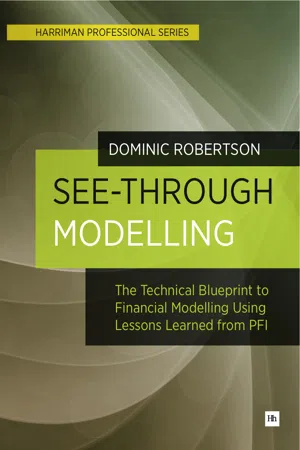
See-Through Modelling
The Technical Blueprint to Financial Modelling Using Lessons Learned from PFI
- 299 pages
- English
- ePUB (mobile friendly)
- Available on iOS & Android
See-Through Modelling
The Technical Blueprint to Financial Modelling Using Lessons Learned from PFI
About This Book
Building and maintaining effective financial modelsSee-Through Modelling provides a solid theoretical and practical basis for becoming an advanced financial modeller in Excel. It gives the theory and practical detail necessary to build and maintain a financial model yourself. This is done with particular reference to project finance and by drawing upon the lessons learned from UK PFI.In this book Dominic Robertson covers the key aspects of financial modelling, including:- Financial theory- Modelling theory- Excel theory and techniques- A step-by-step practical guide to building a project finance operating model- Computer set-up and efficient use- Keyboard skills- Macro-economic data collectionHe also includes key practical techniques such as how to:- Greater strategic vision due to vast forecast flexibility - Lower risk of modelling errors due to standardised modelling- Decrease reliance on individual analysts due to increased ease of model interchange- Clear, detailed and holistic modelling function training outlineLearning to build a UK PFI project finance model is an extremely good place to start to learn financial modelling. UK PFI is like the world in miniature with simplified operations and simplified finance but containing all the accounting and cash elements that make for a wide-ranging experience.See-Through Modelling is for finance directors who are looking for a deeper understanding of the dynamics of their enterprise and those who want to understand the benefits of adopting a see-through modelling strategy within their enterprise. It is also an invaluable resource for aspiring financial modellers in general and project finance modellers in particular.
Frequently asked questions
Information
PART 1: THEORY
- Modelling theory
- Finance theory
- FAST theory
- Excel theory
- Computer theory.
Chapter 1. Modelling theory
Definition of modelling
- Financial modelling – the PFI model is a financial model and a financial model has a P&L (profit & loss), CF (cash flow) and BS (balance sheet) as main results
- Econometric modelling – the results vary but the main content is of an econometric nature including any or all of:
- elasticities to derive volume, supply or demand of goods or services
- regression analysis or other statistical means to forecast volume, supply or demand of goods or services
- Deterministic modelling – where the model derives one set of results
- Probabilistic modelling – where the model can derive a distribution of the set of results
- Simulation modelling – where the model can be run a number of times, while changing one or more variables across a pre-determined range, to derive a distribution of the set of results
- Operational modelling – where the model uses management accounting and other actuals to forecast and where the actual updating process happens at regular intervals
- Strategic financial modelling – where the model provides the company’s senior management with answers to the possible direction of the company’s future finances
- Budget financial modelling – where the model provides short-term detailed financial variance analysis by comparing actuals data to budget data.
A short history of modelling
The four founding principles of modelling
1. A model is a model, not reality
2. A model must be as simple and clear as possible
3. A model must answer the commercial needs of the user
4. As above so below
The modelling mind-set
The body of modelling theory
- Struc...
Table of contents
- Cover
- Publishing Details
- About the author
- Preface
- Introduction
- PART 1: THEORY
- PART 2: PRACTICE
- PART 3: FURTHER LESSONS
- APPENDICES
- Lazuli Solutions